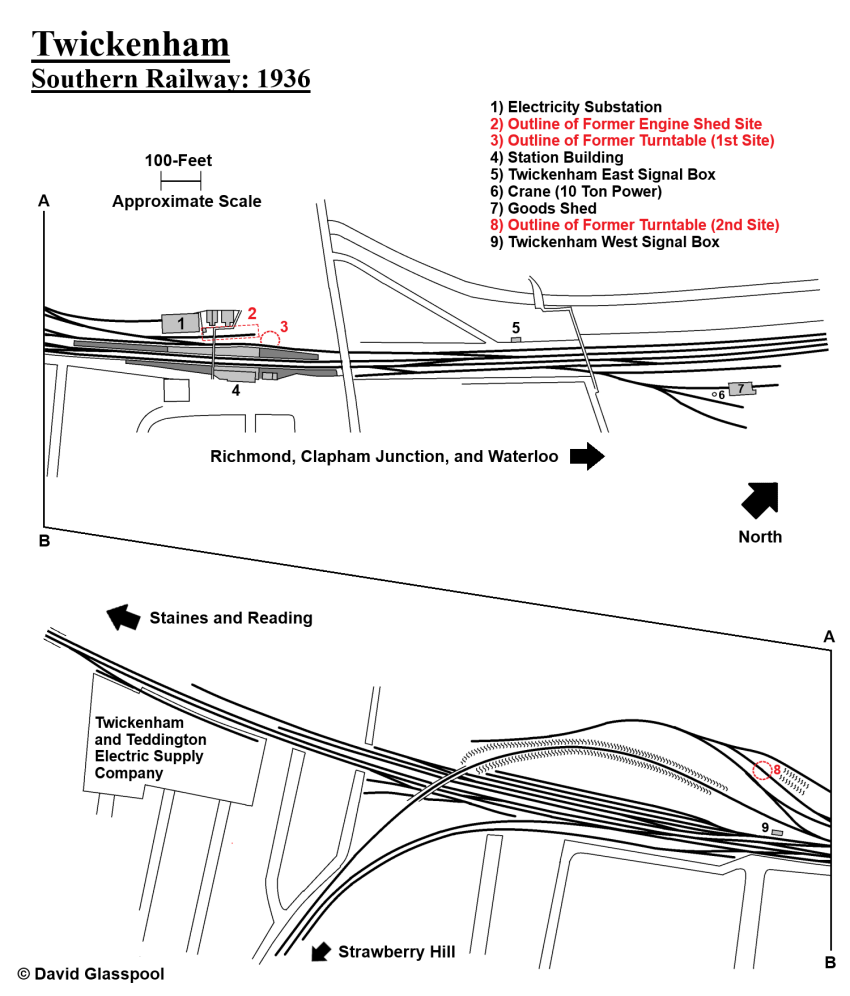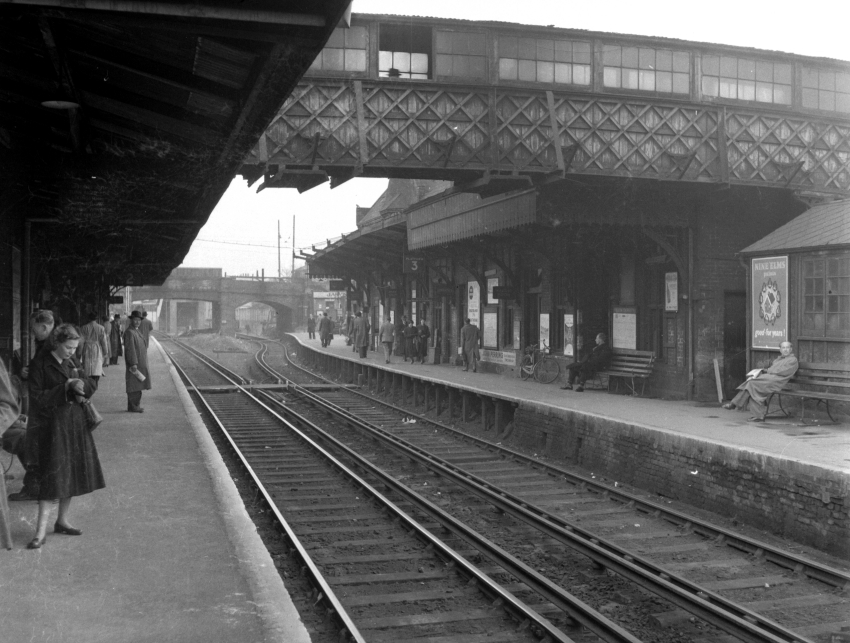Twickenham
First Station
Closed as long ago as 1954, today there is no trace of Twickenham's first station. Once situated on a site southwest of today's platforms, on the opposite side of the bridge that carries London Road (A310) over the rails, the oldest structure in evidence is a substantial red brick substation dating from electrification of the Kingston Loop, this itself having occurred over a century ago during World War I.
Scheduled passenger services of the London & South Western Railway (LSWR) reached Richmond from what became Clapham Junction on 25th July 1846 (ref: The Official Guide to the London & South Western Railway, Cassell & Company Limited, 1894). Extension beyond Richmond, to Datchet and Windsor, was made under an independent concern by the name of the Windsor, Staines, and South Western Company, incorporated in 1847. A double-track line opened to scheduled passenger traffic between Richmond and Datchet on 22nd August 1848 (ref: The Railway Magazine, June 1911), a station at Twickenham coming into use at this time. In the Windsor and Eton Expres on 29th July 1848, it was stated that "the station [at Staines] and engine houses are, as is the case along the entire line, temporary", suggesting that at Twickenham and neighbouring stations, permanent platforms and structures had yet to be built. Extension of scheduled passenger services from Datchet to Windsor occurred on 1st December 1848 (ref: The Railway Magazine, June 1911).
A two-platform affair was built at Twickenham, around the double-track. A substantial main building of brick construction was situated on the "down" (west-bound) platform. The architecture was much aligned with the Gothic style that became prevalent between Yeovil and Exeter, suggesting that this was a product of William Tite. The 1864 Ordnance Survey edition shows a platform canopy, about 60-feet-long, attached to the main building; the "up" side was provided with a canopy of about 70-feet length, which your author assumes was attached to a large waiting shelter. In the early years, passengers crossed on the level between platforms.

The layout is seen at its peak, when extensive sidings existed within the semi-circle formed by the running lines and flying junction carrying the "up" track from Strawberry Hill. Former positions of the turntable and engine shed are marked. Click the above for a larger version. © David Glasspool
On 1st July 1863, a double-track branch, about 3⅓-miles in length, opened from Twickenham to Kingston, with intermediate stations at Teddington and Hampton Wick. The LSWR already had a station on their main line named "Kingston": this was renamed to "Surbiton" on the opening of the branch (ref: Morning Herald (London), 3rd July 1863). A flat junction was made about 330-yards south west of the platforms, the branch being accessible to trains heading away from London. Your author speculates that it was at the time of the branch’s opening that an engine shed and turntable were brought into use adjacent to Twickenham station — both are evident on the 1864 Ordnance Survey edition. The latter depicts a two-road dead-end shed, about 130-feet in length, located behind the "up" platform. A turntable was fed by a loop off the "up" line, and the positions of the features so far described can be seen on the accompanying diagram. The December 1920 edition of The Railway Magazine remarks that Twickenham was one of the engine sheds where Beattie's 2-4-0 Well Tanks [of the year 1874] were stabled, to handle the LSWR’s extensive suburban traffic.
In a Board of Trade report dated 24th April 1875, concerning a collision at Twickenham station on 19th of that month, it was noted that an 18-lever signal cabin was situated about 300-yards west of the platforms, by the junction between Windsor and Kingston lines. Both routes and the junction were worked on the block system.
In 1882, a flyover came into use at Twickenham Junction (ref: The South Western Railway. Its Mechanical History and Background, 1838-1922, Cuthbert Hamilton Ellis), west of the station. This carried the single track of the "up" line from Kingston over the double-track running lines to Staines and five sidings. Alterations at the station appear to have been substantial in connection with the flyover works: the "up" platform was converted to an island, lengthened, and linked to the "down" side by an enclosed footbridge; the engine shed was retained, but the turntable relocated west of the station, north of the incoming Kingston "up" line; a complicated array of points at the junction were brought into use, linking the running lines with a series of sidings. Your author surmises that it was around this time that the signal box mentioned in the 1876 Board of Trade report was replaced by a larger 48-lever cabin by the name of Twickenham West, brought into use in the fork of the running lines and the incoming "up" single-track from the Kingston branch. Another cabin, by the name of Twickenham East, came into use on the opposite side of the road bridge, on the "up" side of the line, about 170-yards from the platforms. A signal box also existed in-between the eastern end of the "up" platform and road bridge, and although evident on the 1896 Ordnance Survey edition, likely predated the alterations made in connection with the flyover.
March 1954

This Richmond-bound view was taken during the month the station was closed and replaced by five platform faces on the opposite side of the road bridge seen in the background. The “down” platform (No. 3), seen on the right, had to be partially rebuilt in timber to permit the slewing of the running line to serve the new station. As is evident, the slewing of the track also required partial dismantling of the “down” canopy, including the removal of most of the valance, to conform to the then new curved platform edge. This view was taken from Platform 2, which was one side of an island. © David Glasspool Collection
Early Ordnance Survey editions show no clear evidence of a goods yard at Twickenham. However, by the 1890s, a yard comprising four sidings had been laid 250-yards north east of the platforms, on the "down" side of the running lines. No goods shed accompanied these sidings from the outset, but a crane of ten ton power was provided (ref: Hand-Book and Appendix of Stations, Junctions, Sidings, Collieries, &C, of the Railways of the United Kingdom, Henry Oliver and John Airey, 1894), and one track terminated at a dock platform.
By 1914, the engine shed had gone, a water tower and tank erected in its place, and the footbridge extended northwards to provide passenger access to the station from the "up" side of the line. Maps of the period show the turntable still being in situ, but it seems likely that this would have been removed during the LSWR’s early suburban electrification projects. Of the latter, electric passenger services were inaugurated between Waterloo and Wimbledon via East Putney on 25th October 1915; electric services from Waterloo to Wimbledon via Richmond, Twickenham, and [New] Malden commenced on 30th January of the following year. In connection with electrification, a large red-brick substation was built on the "up" side of the station at Twickenham. This was one of nine brought into use by the LSWR in 1915 and was equipped with static transformers, rotary converters, and switch gear for converting three-phase alternating current into 600 volts D.C., supplied by Durnsford Road Power House, Wimbledon (ref: The Railway Magazine, October 1915).
In the 8th July 1938 edition of the Surrey Mirror and County Post newspaper, it was reported that the Southern Railway (SR) had prepared plans for the complete rebuilding of Twickenham station. On 26th June 1938, a replacement signal box was brought into use at Twickenham East (ref: Volume 4 Southern Railway Register Section R7: Clapham Junction to Staines East, Signalling Record Society). Period photographs show that the "down" line through the existing station was slewed on a revised, more southerly alignment beneath the road bridge, which required the eastern end of the platform on that side to be rebuilt.
April 1954

This south westward view, looking in the Staines direction, was taken from the then new Twickenham station that remains in use today. The island platform of the closed station already had piles of debris upon it, demolition being underway. Like its predecessor, the new station had a fully enclosed footbridge. Today, there is no trace of the 1848 station — the oldest structure that remains is the electricity substation from 1915. Although period maps mark the station as "Twickenham Junction", based on your author's research it was only ever plain "Twickenham". © David Glasspool Collection
New platforms were constructed north east of the existing station, on the opposite side of the road bridge. In the 10th December 1938 edition of the Richmond Herald, it was reported that the new platforms were used for the first time on 6th of that month by large crowds attending an inter-varsity rugby match. However, the platforms were not ready for general traffic and the existing Twickenham station remained in use. There had previously been a wood-and-ash platform on the east side of the road bridge, next to the "up" relief line, which was used by rugby specials (ref: The Railway Magazine, June 1954).
The outbreak of World War II saw construction work on the SR’s then new Twickenham station cease. Formation of the platforms was said to be well-advanced by that stage, and building work recommenced in early 1953 (ref: The Railway Magazine, April 1953).
An Odeon-style signal box was brought into use by the SR at Twickenham West on 19th January 1947, closure of its predecessor having been effective from that date (ref: Volume 4 Southern Railway Register Section R7: Clapham Junction to Staines East, Signalling Record Society). However, the new Twickenham station was not brought into use until 9:00 AM on Sunday, 28th March 1954; even then, construction was not completely finished and, initially, temporary wooden buildings upon the platforms had to suffice (ref: RCTS’ The Railway Observer, May 1954). Closure of the previous Twickenham station was effective from that day and demolition of the site commenced the following Monday (29th March), progress being rapid (ref: RCTS’ The Railway Observer, May 1954).
The commissioning of the replacement station required a considerable amount of re-signalling work, which had involved the suspension of services from 11:35 PM on 27th March to 9:00 AM the following day to allow the last parts of this to be completed. During these works, illuminated track diagrams were installed in both West and East signal boxes (ref: RCTS’ The Railway Observer, May 1954).
In 1954, replacement of the flyover bridge west of Twickenham station, which carried the "up" track of the Kingston Loop over the Windsor Lines, was required. A huge steel plate and girder structure was assembled in three sections by Messrs. Westwoods of Millwall, these parts being delivered to the site by road on the Sunday mornings of 7th March, 4th April, and 2nd May 1954 (ref: RCTS’ The Railway Observer, May 1954).
The last remaining part of the old station, the goods yard, was eventually closed to traffic on and from 2nd January 1967 (ref: Clinker’s Register, 1980).
Return to the Kent Rail Homepage or alternatively, check for Updates.
Website & Copyright information - Links - Contact the Webmaster
